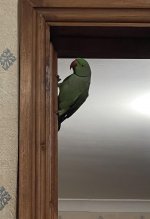Hi brief details , my parrot does not live in a cage his choice, since we got rid of the cage last year he been very happy and although Avery raised he now flies to me and takes food from my hands, eats with us at the table. We have had him 3 years and had him since he was 4 months old. So during his last moult I noticed he looks particularly scruffy and his ring came through but the raggedy wings did not change. He’s been moulting again this last month and they are still raggedy, he flies well and I’ve been trying to give him a better diet , tried different seed mixes and some pellets , he has fresh fruit daily and veg, although he is very picky and chucks most of it, he likes to try what we eating so I let him have bit but obviously nothing poisonous. He spends his time on one of his stands perches , has a habit of peeling the wallpaper but is afraid of any toys that I buy him. I’m really worried as I thought new feathers would of replaced the raggedy ones by now, I’ve not noticed any over preening , he baths in his water bowl but is afraid of spray bottle. Is he unhappy , he seems happy and sings, I’ve given cucumber and egg yoke during this moult to help the feathers grow.  please help
please help


 please help
please help

Attachments
Last edited by a moderator:






